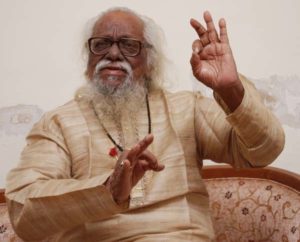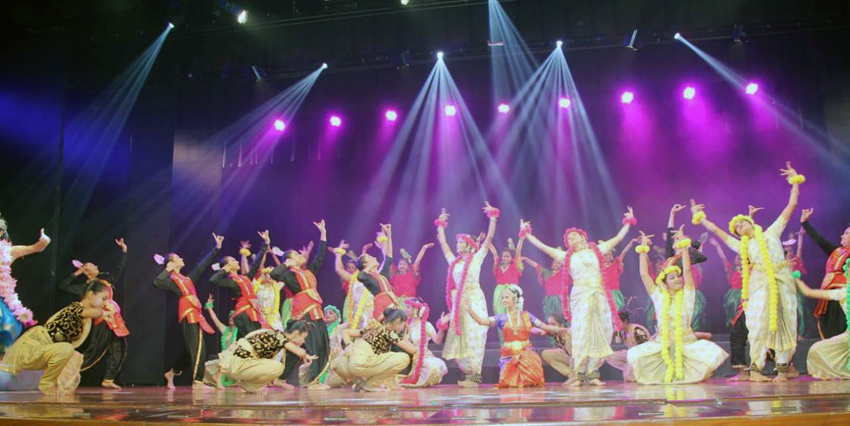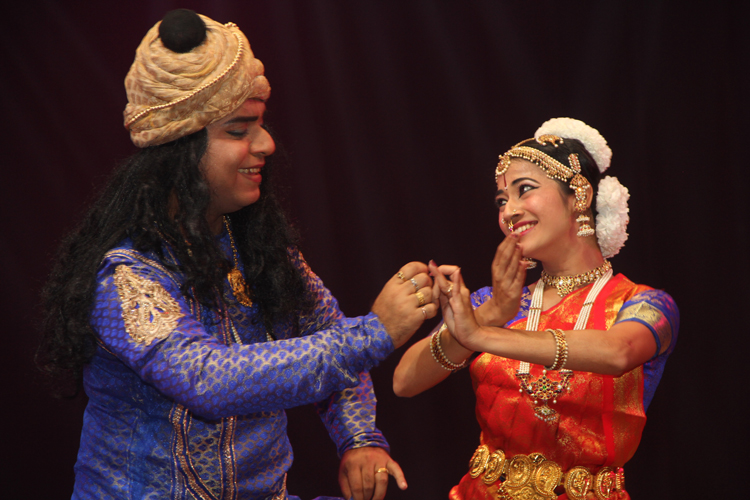Dr Sandhya Purecha, the prime disciple of Acharya Parvati Kumar under the aegis of her Bharata College of Fine Arts & Culture, Mumbai celebrated the 100th birth anniversary at Ravindra Natya Mandir and at The Nehru Centre. She has planned to have 100 events in memory of her guru during the course of the year.
The first Palash, as she has termed the event was, after Guru Vandana, an erudite lecture on Natyashastra by SNA Awardee and Padma Shri Dr Puru Dadhich. It was also announced that for the first time a certificate course will be organized in relation to Natyashastra and Kathak. Dr Puru Dadhich gave discourse which was minus any jargons and was illustrated with many examples, which made the content of the Natyashastra easy to understand. He covered all the chapters in accessible manner throwing light on the concept and meaning as enunciated in Natyashastra.

It was important that such a discourse was planned. Acharya Parvati Kumar had done a deep study of Abhinaya Darpana and also choreographed all the shlokas in Bharatanatyam technique, which he had taught to Sandhya. The entire presentation as performed by Sandhya is recorded and is with IGNCA, New Delhi.

Prior to a lecture by Dr Puru Dadhich, Darshana Jhaveri reminisced about her long association with Parvati Kumar. His deep interest in Natyashastra and related texts were admired by her Manipuri Guru Bipinsingh. Darshana also referred to Parvati Kumar’s main contribution for research in Maratha Rajas’ compositions in Marathi during their rule in Thanjavur in South India. The research in Korvyanche Sahitya and compositions known as Nirupanas by Shahji, Sarfoji have now become a part of the Bharatanatyam dance scene. In that area, Sucheta Bhide Chapekar and Sandhya Purecha’s practical performances have been most significant. Sandhya has been teaching and performing them.
I recalled my association with Guruji from his early choreographic works like Dekh Teri Bambai, which was contemporary and far ahead of its time and presented at All India Dance Seminar and festival in 1958 at New Delhi. His early work of Discovery of India was attended by Pandit Nehru. Guruji received support from INT and its secretary Damu Jhaveri. Those were the years when dance dramas were popular. Guruji’s lifetime work Marathi Nrityagita Prabandh was supported by the Govt of Maharashtra. The renowned dramatist, author, musician P.L Deshpande had recommended the work to the Govt. Its publication is an addition to the literature on Bharatanatyam.
27th February was also Maharashtra Divas. So in the evening, a mega-production Rituchakra in Marathi was undertaken by Sandhya as a tribute to Maharashtra and her Guru. In terms of participation of nearly 100 disciples of Sandhya from various branches in Mumbai, the production was all-inclusive. The lead performances were by guest artist Pavitra Bhat as Kamadeva and from London Suhani Dhaky as Rati. Sutradhar’s role was performed by Karan Kishan (from Nashik) and of Nati by Chitra Dalvi, whereas in the role of Shiva was by Shanti Mohanty Dave (from Raipur), Indra by Kailas Nene. In the role of Parvati was Bijal Heria, from Ahmedabad with few of her students, who played various apsaras.
The Marathi script was by Sadanand Dabir, music Asha Khadilkar, costumes by Bhavana Shah and Navnit Patil. Dramatic lighting was by Mishraji of the Nehru Centre. The script was based on Kalidasa’s Kumar Sambhavam and Ritu Samhara. The mythological story of the annihilation of Tadakasura demon was possible by the only son of Lord Shiva and Parvati. Indra rushed to sage Narada who explained to him that such a demon can be killed by a more powerful divine force. Indra ordered Kamadeva to strike flowery arrows on Lord Shiva was in Samadhi. Parvati was doing penance to marry Lord Shiva. Kamadeva begged forgiveness as he knew that Shiva would with his third eye turn him into ashes. But he was persuaded to help the Gods. The season was of spring. Kamadeva and Rati created an atmosphere of joy, conducive for love between Shiva and Parvati.
The unfolding of the dance drama was spelling binding. One marvelled at Sandhya’s ability to choreograph various sequences in a seamless manner, with well-trained dancers. The roles given to young dancers for the season, where flowers bloomed, deer jumped, and birds flew and all the pancha bhutas, air, water, earth, ether and fire generated appropriate atmosphere. The sequences of pancha bhutas were choreographed with imagination. The young dancers took various poses including some of the ‘karanas’ employed artistically.
The duet by Kamadeva and Rati with their exquisite aharya of garland of flowers was eye-catching. Both the dancers have thorough training in Bharatanatyam and made an attractive pair. Lord Shiva was shown seated in right-hand side and on left-hand side on another platform on which the narrators performed. Space was well covered. The lighting arrangement highlighted the division of space.
To produce and rehearse such a dance-drama on such scale is a formidable task. The plus point was the use of lyrics in the Marathi language with melodious music. Sandhya with invaluable help from her colleagues, disciples and parents succeeded in mounting such engrossing dance drama which appealed to cognoscenti and the lay alike.
Sandhya ‘s aim is noble becoming a devoted disciple. A scholar, guru, performer and choreographer, she is also an able administrator, running the college affiliated to Kavikulaguru Kalidasa University, Nagpur. The horizontal growth of classical dance education among the cultured Maharashtrian families and others is praiseworthy. With five branches across Mumbai city and suburbs, it has shown commendable results. The academic side has received due importance. As a scholar, Sandhya has besides her thesis and publication of the same translated in Marathi and Gujarati 17 chapters of Natyashastra as part I and the other chapters are due for completion. The publications in Gujarati and Marathi are the need of the hour.
The legendary musician Paluskar used to say, “I do not want to produce several Tansens, but if there are hundreds of music lovers we will have kansens who will see that our cultural heritage is preserved.” It applies to the field of classical dances. More so in case of the most popular form of Bharatanatyam. Sandhya Purecha with her untiring zeal and dedication to her Guru has been doing commendable work in that direction.











